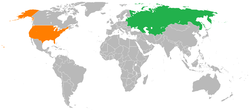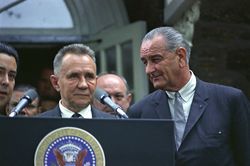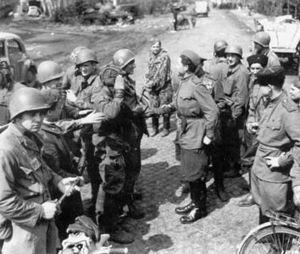العلاقات الأمريكية السوفيتية
 | |
الاتحاد السوڤيتي |
الولايات المتحدة |
|---|---|
The relations between the United States of America and the Union of Soviet Socialist Republics (1922–1991) succeeded the previous relations from 1776 to 1917 and predate today's relations that began in 1992. Full diplomatic relations between the two countries were established late due to mutual hostility. During World War II, the two countries were briefly allies. At the end of the war, the first signs of post-war mistrust and hostility began to appear between the two countries, escalating into the Cold War; a period of tense hostile relations, with periods of détente.
. . . . . . . . . . . . . . . . . . . . . . . . . . . . . . . . . . . . . . . . . . . . . . . . . . . . . . . . . . . . . . . . . . . . . . . . . . . . . . . . . . . . . . . . . . . . . . . . . . . . . . . . . . . . . . . . . . . . . . . . . . . . . . . . . . . . . . . . . . . . . . . . . . . . . . . . . . . . . . . . . . . . . . . .
مقارنة البلدين
| الاسم الشائع | الاتحاد السوڤيتي | الولايات المتحدة |
|---|---|---|
| الاسم الرسمي | اتحاد الجمهورية الاشتراكية السوڤيتية | الولايات المتحدة الأمريكية |
| الدرع | 
|

|
| العلم | 
|

|
| المساحة | 22,402,200 km² (8,649,538 sq mi) | 9,526,468 km² (3,794,101 sq mi)[1] |
| التعداد | 293,047,571 (1991) | 252,127,402 (1991) |
| الكثافة السكانية | 13.1 /km² (33.9 /sq mi) | 33.7/km² (87.4/sq mi) |
| العاصمة | موسكو | واشنطن |
| أكبر منطقة عمرانية | موسكو | مدينة نيويورك |
| الحكومة | Federal Marxist–Leninist one-party socialist state | Federal presidential constitutional republic two-party system |
| الأحزاب | Communist Party of the Soviet Union | Democratic Party Republican Party |
| Most common language | Russian | English |
| GDP (nominal) | $2.9 trillion (~$9,896 per capita) | $5.2 trillion (~$20,624 per capita) |
| Intelligence agencies | Committee for State Security (KGB) | Central Intelligence Agency |
| Military expenditures | $290 billion (1990) | $409.7 billion (1990) |
| Navy size | Soviet Navy (1990)[2]
|
US Navy (1990)
|
| Air force size | Soviet Air Force (1990)[3]
|
US Air Force (1990)
|
| Nuclear warheads (total) | 37,000 (1990) | 10,904 (1990) |
| التحالف الاقتصادي | Comecon | European Economic Community Organisation for Economic Co-operation and Development |
| التحالف العسكري | حلف وارسو | ناتو |
| Countries allied during the Cold War | حلف وارسو:
Soviet Republics seat in the United Nations: Baltic States as Soviet Republics: Other Soviet Socialist Republics:
Other allies:
|
NATO:
Status of the Baltic States during occupation: Other allies:
|
Leaders of the Soviet Union and the United States from 1917 to 1991.

العلاقات قبل الحرب العالمية الثانية
1917-1919
Following the October Revolution in 1917, the U.S. government was hostile to Soviet Russia. The United States extended its embargo of Germany to include Russia.[5][6] The United States sent troops to Siberia in 1918 to protect its interests from Cossacks; thousands of troops were landed at Vladivostok and at Arkhangelsk.[7][8]
الاعتراف في 1933
الحرب العالمية الثانية (1939-45)
 مقالة مفصلة: الحرب العالمية الثانية
مقالة مفصلة: الحرب العالمية الثانية
Before the Germans decided to invade the Soviet Union in June 1941, relations remained strained, as the Molotov–Ribbentrop Pact stirred even more cause for concern in the minds of the Allies. Come the invasion of 1941, the Soviet Union entered a Mutual Assistance Treaty with Great Britain, and received aid from the American Lend-Lease program, relieving American-Soviet tensions, and bringing together former enemies in the fight against the Nazi Germany and the Axis powers.
الحرب الباردة (1945-91)
 | |
الولايات المتحدة |
الاتحاد السوڤيتي |
|---|---|

انظر أيضاً
الهامش
- ^ "United States". Encyclopædia Britannica. Retrieved January 31, 2010.
- ^ "Soviet Navy Ships - 1945-1990 - Cold War". GlobalSecurity.org.
- ^ a1c80d6c8fdb/UploadedImages/Mitchell%20Publications/Arsenal%20of%20Airpower. pdf "Arsenal of Airpower". the99percenters.net. March 13, 2012. Retrieved July 28, 2016 – via Washington Post.
{{cite web}}: Check|url=value (help) - ^ a1c80d6c8fdb/UploadedImages/Mitchell%20Publications/Arsenal%20of%20Airpower. pdf "Arsenal of Airpower". the99percenters.net. March 13, 2012. Retrieved July 28, 2016 – via Washington Post.
{{cite web}}: Check|url=value (help) - ^ "Review of book by David S. Foglesong, America's Secret War Against Bolshevism: U.S. Intervention in the Russian Civil War, 1917–1920". Humanities and Social Sciences On-Line.
- ^ David S. Foglesong, "American Intelligence Gathering, Propaganda and Covert Action in Revolutionary Russia", America's Secret War Against Bolshevism: U.S. Intervention in the Russian Civil War 1917–1920, https://books.google.com/books?id=RUHn9nCC9EoC&dq=US+intervention+in+Russia&printsec=frontcover&source=in&hl=en&ei=0AM9S4uLMIOXlAf6pMSBBw&sa=X&oi=book_result&ct=result&resnum=11&ved=0CDEQ6AEwCg#v=onepage&q=US%20intervention%20in%20Russia&f=false
- ^ Georg Schild, review of Carl J. Richard "When the United States Invaded Russia: Woodrow Wilson's Siberian Disaster." Journal of American History 100.3 (2013): 864-864.online
- ^ Gibson Bell Smith (Winter 2002), Guarding the Railroad, Taming the Cossacks The U.S. Army in Russia, 1918–1920, 34, The National Archives, http://www.archives.gov/publications/prologue/2002/winter/us-army-in-russia-1.html


